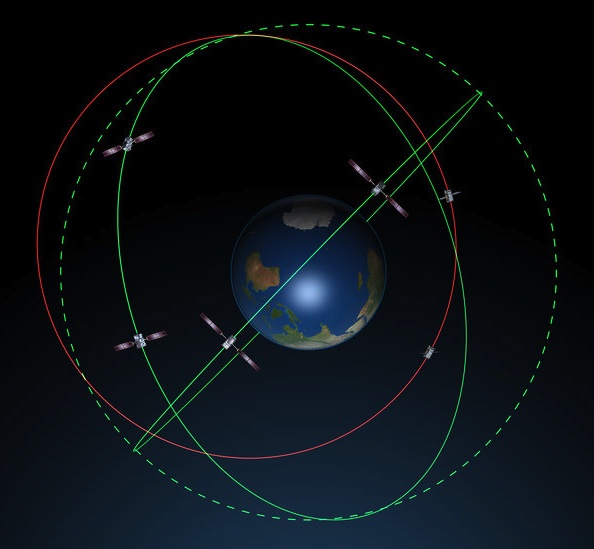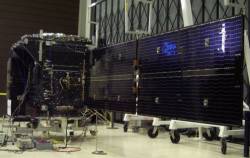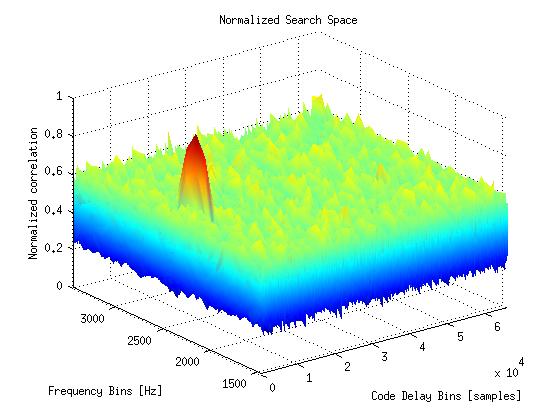Europe’s fifth Galileo satellite, one of two delivered into a wrong orbit by a Russian Soyuz-Fregat launcher in August, transmitted its first navigation signal in space on Saturday (November 29, 2014) after reaching its new target orbit.
According to the European Space Agency (ESA), a detailed test campaign is under way now the satellite has reached a more suitable orbit for navigation purposes.
Europe’s fifth Galileo satellite, one of two delivered into a wrong orbit by a Russian Soyuz-Fregat launcher in August, transmitted its first navigation signal in space on Saturday (November 29, 2014) after reaching its new target orbit.
According to the European Space Agency (ESA), a detailed test campaign is under way now the satellite has reached a more suitable orbit for navigation purposes.
The first two full operational capability (FOC) Galileo satellites ended up in an elongated orbit that extended up to 25,900 kilometers above Earth and as low as 13,713 kilometers. They also were in an incorrect plane more than 3,000 kilometers off target. The intended orbit would have been circular, inclined at 55 degrees to the equator at an altitude of 23,222 kilometers.
A total of 11 maneuvers were performed over the course of 17 days, gradually nudging the fifth satellite (Galileo-FOC FM1) upwards at the lowest point of its orbit. As a result, it has risen more than 3,500 kilometers, rendering its orbit more circular.
"The maneuvers were all normal, with excellent performance both in terms of thrust and direction," explained Daniel Navarro-Reyes, ESA Galileo mission analyst. "The final orbit is as we targeted and is a tribute to the great professionalism of all the teams involved."
The commands were issued from the Galileo Control Center at Oberpfaffenhofen, Germany by Space Opal, the Galileo operator, guided by calculations from a combined flight dynamics team of ESA’s Space Operations Center (ESOC) in Darmstadt, Germany, and France’s CNES space agency.
The commands were uploaded to the satellite via an extended network of ground stations, made up of Galileo stations and additional sites coordinated by CNES. Satellite manufacturer OHB also provided expertise throughout the recovery, helping to adapt the flight procedures.
Until the manoeuvers started, the combined ESA-CNES team maintained the satellites pointing at the Sun using their gyroscopes and solar sensors. This kept the satellites steady in space but their navigation payloads could not be used reliably.
In the new orbit, the satellite’s exposure to radiation in the Van Allen belts has also been greatly reduced, ensuring more reliable performance for the long term.
The revised, more circular orbit means the fifth satellite’s Earth sensor can be used continuously, keeping its main antenna oriented towards Earth and allowing its navigation payload to be switched on.
Significantly, the orbit means that it will now overfly the same location on the ground every 20 days. This compares to a normal Galileo repeat pattern of every 10 days, effectively synchronizing its ground track with the rest of the Galileo constellation, according to ESA.
FOC-FM1 Navigation Test Campaign
The satellite’s navigation payload was activated last Saturday to begin the full “in-orbit test” campaign being conducted from ESA’s Redu center in Belgium, where a 20-meter–diameter antenna will study the strength and shape of the navigation signals with high resolution.
"First, the various payload elements, especially the passive hydrogen maser atomic clock, were warmed up, then the payload’s first ‘signal in space’ was transmitted," said David Sanchez-Cabezudo, managing the test campaign.
"The satellite-broadcast L-band navigation signal is monitored using the large antenna at Redu, with experts from OHB and Surrey Satellite Technology Ltd – the payload manufacturer, based in Guildford, UK – also on hand to analyse how it performs over time."
The first Galileo FOC navigation signal-in-space transmitting in the three Galileo frequency bands (E5/E6/L1) was tracked by Galileo test user receivers deployed at various locations in Europe, namely at Redu (B), ESTEC (NL), Weilheim (D) and Rome (I). The quality of the signal is good and in line with expectations.
A search & rescue (SAR) payload will be switched on within a few days in order to complement the in-orbit test campaign.
The same recovery maneuvers are planned for the sixth satellite, taking it into the same orbital plane but on the opposite side of Earth.
A decision whether to use the two satellites for navigation and SAR purposes as part of the Galileo constellation will be taken by the European Commission based on the test results.
Although plans have not been finalized, the next launch of two Galileo FOCs on board a Soyuz rocket could take place in February 2015, followed by an Ariane 5 launch in the September-October 2015 timeframe. The modified Ariane rocket is capable of launching four satellites at a time.






